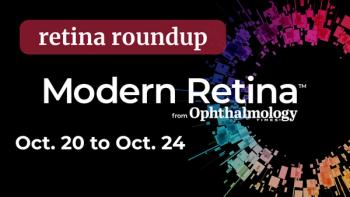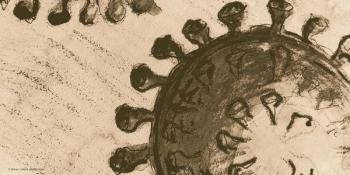
Meta-analysis on DME treatments updated to include treatment regimen
The choice of which anti-vascular endothelial growth factor (VEGF) agent to use on patients with diabetic macular edema (DME) may depend on a variety of variables.
The choice of which anti-vascular endothelial growth factor (VEGF) agent to use on patients with diabetic macular edema (DME) may depend on a variety of variables, including baseline visual acuity (VA), a new meta-analysis has found.1
Pham et al.1 evaluated head-to-head randomized controlled trials (RCTs) comparing aflibercept, bevacizumab, and ranibizumab (or any combination of head-to-head comparisons) in adult patients aged ≥18 years with choroidal neovascular age-related macular degeneration (AMD), DME, macular edema due to retinal vein occlusion, or myopic choroidal neovascularization. The group found three RCTs on DME to include.
“We summarized information regarding treatment regimens (eg, three initial monthly intravitreal injections and as-needed monthly retreatment, treat and extend), as-needed re-treatment criteria and the reconstitution of bevacizumab, and examined the influence of the choice of treatment regimens on the benefits and harms of the anti-VEGF drugs for specific retinal conditions,” the authors wrote.
They excluded any RCT that compared an anti-VEGF agent with other treatments (photodynamic therapy, intravitreal corticosteroids, or grid laser photocoagulation) and limited the study inclusion criteria to only those published in English.
For the patients with DME, the treatment effect estimates were obtained for “all patients” and for subgroups based on baseline best-corrected visual acuity (BCVA).
In general, the group found vision gain was not significantly different in patients with DME treated with bevacizumab compared with ranibizumab.
However, patients with DME treated with aflibercept experienced “significantly higher vision gain at 12 months than patients receiving ranibizumab or bevacizumab,” but the differences were no longer statistically significant at 24 months.1
DME studies’ dosing
For the studies that evaluated anti-VEGF dosing that initiated with three loading doses followed by PRN treatment, the average number of monthly doses per year ranged from 5-6; for the three studies that evaluated three monthly dose loads and then evaluated and/or treated monthly on a PRN regimen (until vision was stable), the median number of injections was 9-10.1
The Diabetic Retinopathy Clinical Research Network (DRCR.net) Protocol T (n = 620) found that over 2 years of treatment, there was no real difference in vision gains between the three anti-VEGFs.2
In Pham et al.’s analysis, they wrote 98% of the patients in Protocol T were able to maintain vision over 2 years, but also evaluated data from two small single-centered RCTs that reported BCVA data. One study compared aflibercept to ranibizumab, the other compared bevacizumab to ranibizumab.3,4
In those studies, patients’ BCVA improved by 13 letters with aflibercept, by 10 letters with bevacizumab, and by 12 letters with ranibizumab.
In the DRCR.net study, mortality was reported in about 6% of bevacizumab patients, in 2% of aflibercept patients, and in 5% of ranibizumab patients. Serious adverse events were lowest in the bevacizumab group (at 21%) and highest in the aflibercept group (at 27%).
Pham et al. wrote that the vision gain was similar among patients treated with each of the three anti-VEGF regimens, but that the first year of treatment found patients on aflibercept were more likely to attain vision than patients on other treatments. The differential effects were observed mainly in patients with initial BCVA <69 letter scores (or 20/50 or worse), but not in those with better vision (20/40 or better at baseline).
“None of the RCTs were designed with sufficient statistical power to detect significant differences between the treatments with respect to the incidence of harms,” they said.
Further, patients with DME tend to receive fewer monthly injections per year than patients with AMD, but none of the trials evaluated monthly mandatory treatments, leaving the authors unable to evaluate safety risks between as-needed and monthly regimens.
Other meta-analyses found similar outcomes; Pham et al. did include the additional factor of treatment regimen. In short, for most retinal conditions, intravitreal bevacizumab “was a reasonable alternative to ranibizumab and aflibercept,” with the notable exception of patients with DME and low baseline VA, where treatment with aflibercept produced better visual outcomes in the first year.
“The choice of anti-VEGF drug may depend on specific retinal conditions, baseline VA, and treatment regimen,” they concluded.
References:
1. Pham B, Thomas SM, Lillie E, et al. Anti-vascular endothelial growth factor treatment for retinal conditions: a systematic review and meta-analysis. BMJ Open 2019;9(5):e022031.
2. Wells JA, Glassman AR, Ayala AR, et al. Aflibercept, Bevacizumab, or Ranibizumab for Diabetic Macular Edema: Two-Year Results from a Comparative Effectiveness Randomized Clinical Trial. Ophthalmology 2016 123(6):1351-9.
3. Fouda SM, Bahgat AM. Intravitreal aflibercept versus intravitreal ranibizumab for the treatment of diabetic macular edema. Clin Ophthalmol 2017;11:567-71.
4. Ekinci M, Ceylan E, Ãakıcı Ã, et al. Treatment of macular edema in diabetic retinopathy: comparison of the efficacy of intravitreal bevacizumab and ranibizumab injections. Expert Review of Ophthalmology 2014;9(2):139-43.
Newsletter
Keep your retina practice on the forefront—subscribe for expert analysis and emerging trends in retinal disease management.















































